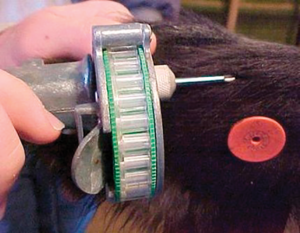Growth Stimulating Implants for Beef Cattle
go.ncsu.edu/readext?794802
en Español / em Português
El inglés es el idioma de control de esta página. En la medida en que haya algún conflicto entre la traducción al inglés y la traducción, el inglés prevalece.
Al hacer clic en el enlace de traducción se activa un servicio de traducción gratuito para convertir la página al español. Al igual que con cualquier traducción por Internet, la conversión no es sensible al contexto y puede que no traduzca el texto en su significado original. NC State Extension no garantiza la exactitud del texto traducido. Por favor, tenga en cuenta que algunas aplicaciones y/o servicios pueden no funcionar como se espera cuando se traducen.
Português
Inglês é o idioma de controle desta página. Na medida que haja algum conflito entre o texto original em Inglês e a tradução, o Inglês prevalece.
Ao clicar no link de tradução, um serviço gratuito de tradução será ativado para converter a página para o Português. Como em qualquer tradução pela internet, a conversão não é sensivel ao contexto e pode não ocorrer a tradução para o significado orginal. O serviço de Extensão da Carolina do Norte (NC State Extension) não garante a exatidão do texto traduzido. Por favor, observe que algumas funções ou serviços podem não funcionar como esperado após a tradução.
English
English is the controlling language of this page. To the extent there is any conflict between the English text and the translation, English controls.
Clicking on the translation link activates a free translation service to convert the page to Spanish. As with any Internet translation, the conversion is not context-sensitive and may not translate the text to its original meaning. NC State Extension does not guarantee the accuracy of the translated text. Please note that some applications and/or services may not function as expected when translated.
Collapse ▲Growth stimulating implants for beef cattle are not new. The oldest commercial one has been around for over 40 years. A lot of research has proven their safety and effectiveness time and time again, yet farmers fail to take advantage of these. These compounds stimulate the body’s own glands to release more of the natural growth hormones. The compounds in hormones are proteins which cannot be absorbed through the digestive system. The digestive enzymes will simply break them down into individual amino acids and their affect would be lost. They must be placed directly into the bloodstream at very small doses over a long period of time. That’s why we call them implants. The pellets are implanted under the skin of the ear. Since the ear is discarded and not used for human consumption, any residues from the pellet will not find their way into the human food chain. Residues in the meat are minuscule. A consumer would ingest thousands of times more estrogen from one serving of coleslaw than he would get from an 8 oz. steak. And the implants really do improve growth rates. In Burke County trials, we’ve consistently gained an extra 30 pounds of beef for each dollar implant. Not using this technology is costing Burke County producers $20 – $30 on each calf they sale.

Photo: American Hereford Association




